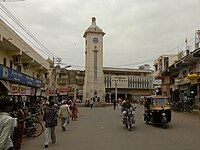
Photo from wikipedia
This study attempts to learn the groundwater salinization mechanism in the large and well-populated coastal Gujarat alluvial plain under growing anthropogenic pressures. For this purpose, geochemical compositions and 87Sr/86Sr were… Click to show full abstract
This study attempts to learn the groundwater salinization mechanism in the large and well-populated coastal Gujarat alluvial plain under growing anthropogenic pressures. For this purpose, geochemical compositions and 87Sr/86Sr were analyzed in 53 groundwater samples collected in the three different seasons during 2016-2017. Additionally, surface water samples collected in each season from two nearby large rivers (Narmada and Tapi) and urban sewage discharge of Surat city were also analyzed. Excluding a few salinity hotspots (EC >8-18 mS/cm), the seasonal average of EC (~2.3-2.5 mS/cm) in groundwater shows little fluctuations negating evaporation as the major salinization process. Localized anthropogenic inputs as traced using NO3 also fail to explain the widespread groundwater salinity. A strong marine influence on the groundwater salinity is revealed by an average Cl/Br of ~655 ± 104 mol/mol in groundwater (except a few outliers) falling close to the seawater composition. The lateral seawater intrusion at shallow depths is generally not supported by the freshening of coastal groundwater samples and generally seaward movements of shallow groundwater as indicated by regional piezometric heads. However, few (Ca)-Mg-Cl type groundwaters collected from north of the Narmada River fall in the piezometric depressions and hint at seawater intrusion and/or upconing of deep saline aquifers. The Sr isotope budget in most of the alluvial groundwater samples is controlled by the seepage groundwater-seawater mixing. Exceptional 87Sr/86Sr values owing to Sr inputs from different age terrains are found in the northeastern groundwater and a few groundwater samples collected downslope of ancient deposits in the central alluvium. The upconing of salty waters having marine signatures partly altered by aquifer-water interactions primarily governs the regional groundwater salinity, which makes the study area vulnerable to continued salinization by excessive groundwater extraction.
Journal Title: Journal of contaminant hydrology
Year Published: 2022
Link to full text (if available)
Share on Social Media: Sign Up to like & get
recommendations!